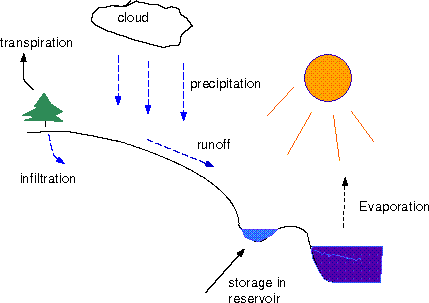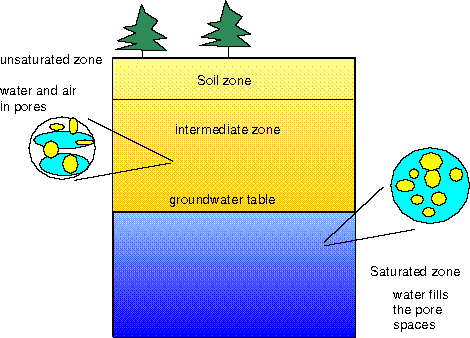
Water is considered essential to life and without a doubt is essential to OUR lives. Without it, we last a day or two. Therefore, a discussion of Earth's fresh water system is an important part of our course entitled "Earth". The study of the world's waters comes under the purview of hydrology, the basic principles of which are the topic of today's lecture.
The Earth is unique in the solar system because water exists in all three of its possible states: solid, liquid and vapor (gas). Water is in constant motion and migrates between the crust and the atmosphere in a never ending cycle, known as the hydrologic cycle.
Water moves from the oceans to the atomosphere, to rainwater, into the crust in streams, glaciers, lakes, and ultimately makes its way back to the ocean. Examine Figure 12.2 and below:

Evaporation is the process by which liquid water is transformed into water vapor, a gas in the atmosphere. The air can hold a certain amount of water vapor, depending on its temperature and pressure. Hot air can hold more water vapor than cold air. The main driving force of evaporation is heat from the sun. Therefore, most evaporation occurs over the oceans at low latitudes. However, water can also be turned to water vapor through the leaves of plants (transpiration), or directly from solid ice (sublimation).
As the air mass moves, it may rise. As it rises, the air pressure drops so it expands. When air expands, it cools. The air then can not hold as much water vapor and the water condenses as droplets in clouds. When a cloud becomes too heavy, it precipitates.
Precipitation occurs when water falls from the sky, either as ice (snow or hail) or liquid water (rain). Precipitation falling onto the ground is either absorbed into the ground by a process known as infiltration or it becomes surface runoff. Water can be stored temporarily in various resevoirs, either above ground in lakes, streams, glaciers, etc., or below ground as groundwater.
Whether the water is infiltrated into the ground or becomes runoff depends upon the ground on which it falls. Asphalt is not particularly absorbant and build-up of cities has significantly affected the ability of water to be absorbed into the groundwater reservoir. Also, the type of vegetation can affect runoff. Cutting down of trees to make croplands reduces the ability of the ground to absorb water quickly, increases runoff and incidently also increases erosion. The deforestation of the uplands of India contribute significantly to the flooding in Bangledesh.
The largest water reservoir is the ocean, containing 97.3% of all water on Earth. This is of course salt water and is toxic unless specially treated to remove the salt.
The next biggest reservoir are glaciers and polar ice containing just over 2% of the available water. While some countries have entertained the possibility of dragging icebergs down from the frozen North and using them as a source of fresh water (notably Saudi Arabia), this is not economically feasable in most cases.
The most important reservoir for drinking water is groundwater. If you dig down into the earth, eventually you will reach water. Water seeps into the cracks and pore spaces within the rock and the amount of water that the ground can hold depends on its porosity. At first as you dig, the ground may not be wet and the pores are filled with air. This is the unsaturated zone (see Figure 12.8 in your book or this picture:

Below the water table, the ground is saturated with groundwater. Earth that is carrying or can carry water is called an aquifer. If the aquifer is surrounded by relatively impermeable layers (aquicludes), the thus confined aquifer is called artesian. Without the aquicludes, the aquifer is unconfined. Aquifers are recharged when water infiltrates them. Artesian aquifers get recharged through windows where the confining aquicludes are missing, or the aquifer intercepts the surface. Recharge is enhanced by natural vegetation cover, flat topography, water permeable soils, deep water table without the interference of confining beds.
Water in an artesian aquifer is confined. Water will spout out of an artesian aquifer if punctured below the water table at the source. This occurs at an artesian well. (see Figure 12.11 in your book).
Groundwater moves through aquifers under the force of gravity. The speed at which it moves depends on the slope of the water table (the hydraulic gradient), the porosity and the ability of the material to transmit water (the hydraulic conductivity). Generally, the most porous rocks, such as sand and gravel, have the highest potential for being productive aquifers. Water flow rates are usually very slow (a few cm per day).
When water exits the aquifer it is called discharge. Discharge can be at locations where the water table intercepts the surface, for example in springs or seeps, or at wells. If discharge exceeds recharge (for example, if there is excessive pumping or a drought in the recharge area), then the water table will be depressed and form a cone around the wells into the aquifer (see Figure 12.13 in you book or this picture

Because ground water moves so slowly, recharging a depleted aquifer takes time - sometimes thousands of years. Also, if ground water gets contaminated, it takes a long time (and/or a lot of money!!!) to clean it up. Consider Figure 12.21 in your book for an education in how to contaminate (or avoid contaminating!) the ground water.
Lisa Tauxe